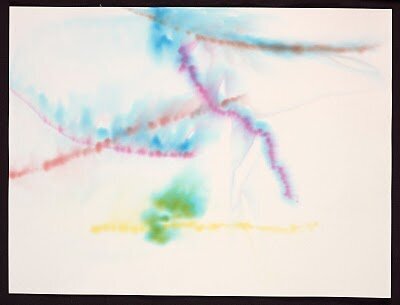Tracey Rowledge was one of 24 creative practitioners to participate in the Cape Farewell expedition, which travelled northwards up the West Coast of Greenland in 2008 to observe climate change.
Rowledge is a fine artist and an accomplished bookbinder, who uses found marks as well as literary texts in her work. Her practice seems to fall between two Victorian trades that are now almost obsolete: the public letter-writer who copies the thoughts of illiterate passers-by onto paper, and the psychic who channels more profound messages from beyond.
"It's a preoccupation - how and why we make marks, and what they mean to me and to other people. A mark always evokes an emotional response," Rowledge says. She rescues notes on scraps of paper discarded in London's gutters, and gold tools them onto leather, the gilt impression true to each scribble and smudge. Bookbinding enables her to use "a non-gestural process to create something that evokes movement and spontaneity - and yet it's completely embedded in the tradition and processes of gold tooling. I love that extreme play."
As a celebrant of human ephemera, how did Rowledge respond to the marks people have left on the Arctic environment? Although she couldn't transport her bindery with her on the ship, a similar sense of movement and constraint is at work in her Arctic Drawings.

Rowledge explains her process: "I took the right kind of paper to apply felt tip to so that the ink would bleed and the image would move. I had the paper cut so it fitted my suitcase and the cabin became my studio. I became very conscious of the movement of the boat and wondered what it would be like if I just leaned over the piece of paper with a pen and used my arm as a pendulum to create a drawing. I collected Arctic water in a cooking pot, and wet the sheet of paper in a baking tray, then left it to air dry in the cabin."
These works are quasi-scientific documents. Created by the movement of the ship with Rowledge as interpreter, they chart weather and water at a particular moment in time, which is noted on each drawing alongside the geographical coordinates. "I worked all the time we were on the boat, and set up a pendulum under the chair in my cabin, so that when I went ashore the drawings would be made in my absence. I recorded the date and time of each and the ship's coordinates - they are very site-specific, a record of our journey."
The scale of the marks and movement is intimate, at times infinitesimal on the large white sheet of paper. It is hard to imagine a more direct interaction with the environment. The association with the water that generated them is intense. "Each drawing is very different. You can see that sometimes the sea was very, very rough. Other drawings look like algae, they are calmer and more contemplative."
Although the bookbinder's craft isn't always about preservation, Rowledge has done a lot of book conservation work. But can the arts of the book protect the future of the environment?
Rowledge responds, "As soon as you feel the weight of what's happening with climate change you think 'Well, why bother making another object? What's the point really?' But then you get driven to make something because that's what it is in your make up to do. You make your ideas physical. They have to exist. You just focus on the idea and lose the bigger picture - that's survival."
Picture Credit: Arctic Drawing: Series 3, no.9
Cape Farewell 2008 Disko Bay Expedition
2 October
350 x 460 mm
Colour felt tip and Arctic water on paper
Photography by Prudence Cuming Associates Ltd
